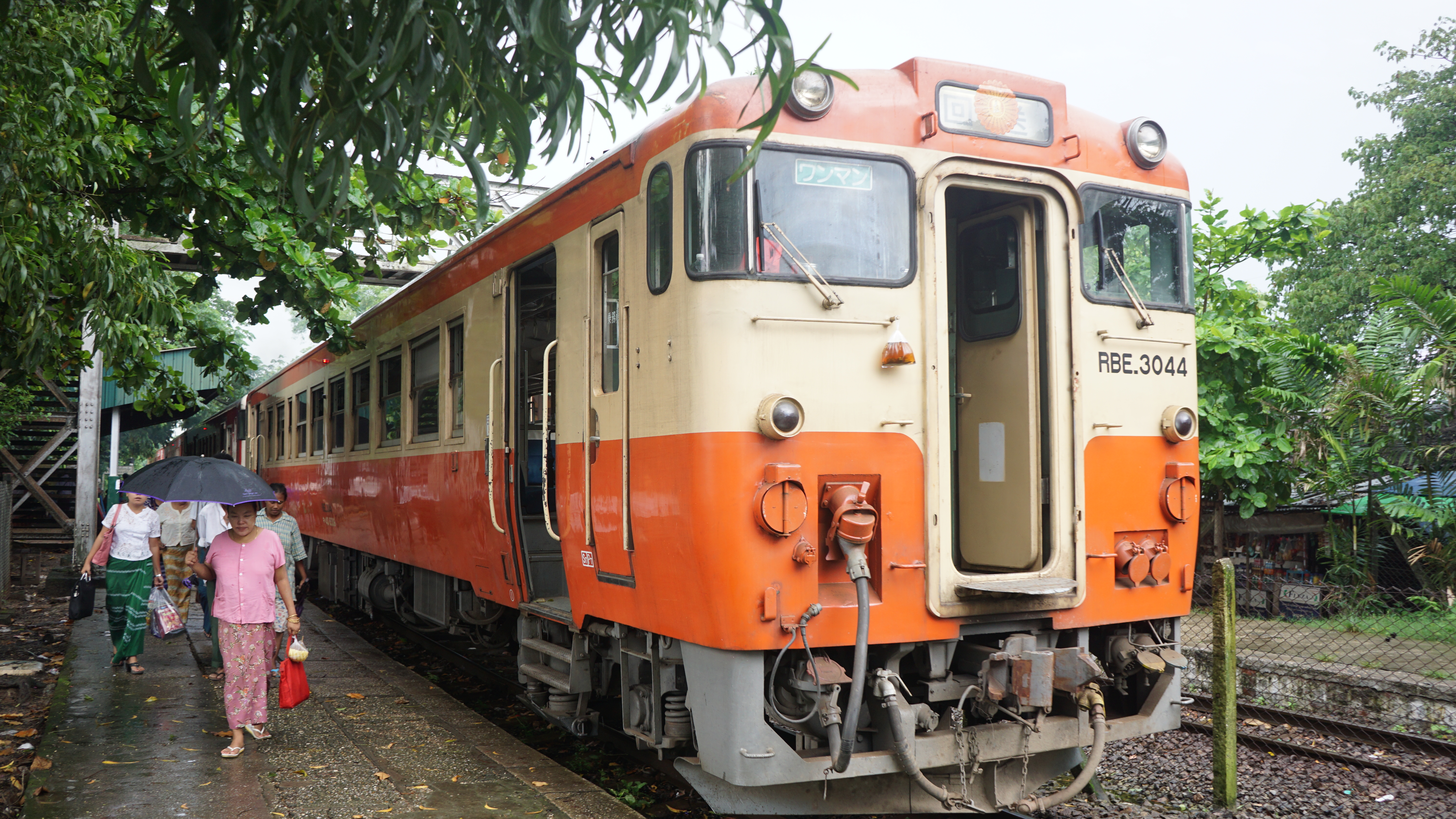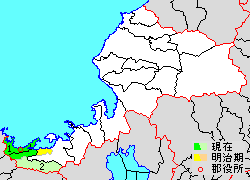|
Obama Line
The is a railway line on the Sea of Japan coast of central Japan. It is operated by West Japan Railway Company (JR West). The long single track railway connects Tsuruga Station on the Hokuriku Main Line in Tsuruga, Fukui Prefecture and Higashi-Maizuru Station on the Maizuru Line in Maizuru, Kyoto Prefecture. The city of Obama and the towns of Mihama, Wakasa, Ōi and Takahama are located in the central section of the line. History The Tsuruga - Tomura section opened in 1917, and the line was then extended westward to Obama in 1918, Wakasa-Takahama in 1921 and connected to the Maizuru Line at Higashi-Maizuru the following year. Freight services between Tsuruga and Mitsumatsu ceased in 1997. The line was electrified on March 15, 2003. Stations Rolling stock The line uses single-car 125 series EMU cars, sometimes substituted by 521 series EMU cars. And the limited express Hanaakari which used KiHa 189 DMU cars. Former * KiHa 20 * KiHa 48 * KiHa 53 * KiHa 26 ... [...More Info...] [...Related Items...] OR: [Wikipedia] [Google] [Baidu] |
Fukui Prefecture
is a Prefectures of Japan, prefecture of Japan located in the Chūbu region of Honshū. Fukui Prefecture has a population of 737,229 (1 January 2025) and has a geographic area of 4,190 Square kilometre, km2 (1,617 sq mi). Fukui Prefecture borders Ishikawa Prefecture to the north, Gifu Prefecture to the east, Shiga Prefecture to the south, and Kyoto Prefecture to the southwest. Fukui, Fukui, Fukui is the capital and largest city of Fukui Prefecture, with other major cities including Sakai, Fukui, Sakai, Echizen, Fukui, Echizen, and Sabae, Fukui, Sabae. Fukui Prefecture is located on the Sea of Japan coast and is part of the historic Hokuriku region of Japan. The Matsudaira clan, a powerful ''samurai'' clan during the Edo period that became a component of the Kazoku, Japanese nobility after the Meiji Restoration, was headquartered at Fukui Castle on the site of the modern prefectural offices. Fukui Prefecture is home to the Kitadani Formation and Kitadani Family, the Ichijōdani As ... [...More Info...] [...Related Items...] OR: [Wikipedia] [Google] [Baidu] |
Towns Of Japan
A town (町; ''chō'' or ''machi'') is a Local government, local administrative unit in Japan. It is a local public body along with Prefectures of Japan, prefecture (''ken'' or other equivalents), Cities of Japan, city (''shi''), and Villages of Japan, village (''mura''). Geographically, a town is contained within a Districts of Japan, district. The same word (町; ''machi'' or ''chō'') is also used in names of smaller regions, usually a part of a Wards of Japan, ward in a city. This is a legacy of when smaller towns were formed on the outskirts of a city, only to eventually merge into it. Towns See also * Municipalities of Japan * List of villages in Japan * List of cities in Japan * Japanese addressing system References External links "Large City System of Japan"; graphic shows towns compared with other Japanese city types at p. 1 [PDF 7 of 40 /nowiki>] {{Asia topic, List of towns in Towns in Japan, * ... [...More Info...] [...Related Items...] OR: [Wikipedia] [Google] [Baidu] |
KiHa 40 Series
The is a diesel multiple unit (DMU) train type introduced by Japanese National Railways (JNR) in 1977 and operated by all Japan Railways Group companies on suburban and rural services in Japan. Since 2017, the train type has seen use by other private railway companies in Japan who have purchased withdrawn units from JR Group companies. Additionally, it has also seen use in overseas operations in Myanmar since 2011 and is also scheduled to be used in Thailand. Overview The KiHa 40 series diesel multiple unit was introduced in 1977 by JNR to replace ageing KiHa 10 series DMUs on suburban and rural services nationwide. A total of 888 vehicles were built between 1977 and 1982, broadly divided into three main types: KiHa 40, KiHa 47, and KiHa 48. These were subdivided as shown below, with further variants and modifications made later in their lives by the various JR Group companies. "Cold" regions refers to the Tohoku and Chubu regions. JR Hokkaido Following the privatization ... [...More Info...] [...Related Items...] OR: [Wikipedia] [Google] [Baidu] |
521 Series
The is a dual-voltage AC/DC outer-suburban electric multiple unit (EMU) train type operated by West Japan Railway Company (JR West) and third-sector railway operators IR Ishikawa Railway and Ainokaze Toyama Railway on local services in the Fukui and Kanazawa areas since November 2006. In March 2024, Hapi-line Fukui acquired some sets after taking over the section of the Hokuriku Main Line within Fukui Prefecture from JR West. Design The 521 series was the first dual-voltage suburban EMU type to be built for JR West. The body of the first two batches was based on the 223-5000 series suburban EMU design, with the same WMT102C traction motors. The sets are able to be used on ''wanman'' driver-only operation services. Operations JR West * 521-0 series ** Hokuriku Main Line ( – ) ** Kosei Line ( – ) ** Obama Line ( – , sometimes substituted for 125 series) * 521-100 series ** Nanao Line (from 3 October 2020) Third-sector lines * Hapi-line Fukui * IR Ishikawa Railway L ... [...More Info...] [...Related Items...] OR: [Wikipedia] [Google] [Baidu] |
Ōi District, Fukui
is a district located in Fukui Prefecture, Japan. As of 2003, the district had an estimated population of 18,680 with a density Density (volumetric mass density or specific mass) is the ratio of a substance's mass to its volume. The symbol most often used for density is ''ρ'' (the lower case Greek letter rho), although the Latin letter ''D'' (or ''d'') can also be u ... of 133.18 persons per km2. The total area is 140.26 km2. Municipalities The district consists of two towns: * Ōi * Takahama ;Notes: History District Timeline Recent mergers * On March 3, 2006 - The village of Natashō (from Onyū District) was merged into the expanded town of Ōi. Districts in Fukui Prefecture {{Fukui-geo-stub ... [...More Info...] [...Related Items...] OR: [Wikipedia] [Google] [Baidu] |
Mikatakaminaka District, Fukui
is a district located in Fukui Prefecture, Japan. The district was formed on March 31, 2005 at the same time as the merger of the towns of Mikata (from Mikata District) and Kaminaka (from Onyū District) forming the town of Wakasa. As of October 1, 2020, the district has an estimated population of 14,003 and a density Density (volumetric mass density or specific mass) is the ratio of a substance's mass to its volume. The symbol most often used for density is ''ρ'' (the lower case Greek letter rho), although the Latin letter ''D'' (or ''d'') can also be u ... of 78.45 persons per km2. The total area is 178.5 km2. Towns and villages The district consists of one town: * Wakasa References Districts in Fukui Prefecture {{Fukui-geo-stub ... [...More Info...] [...Related Items...] OR: [Wikipedia] [Google] [Baidu] |
Mikata District, Fukui
is a district located in Fukui Prefecture, Japan. As of October 1, 2005, the district has an estimated population of 11,023 with a density Density (volumetric mass density or specific mass) is the ratio of a substance's mass to its volume. The symbol most often used for density is ''ρ'' (the lower case Greek letter rho), although the Latin letter ''D'' (or ''d'') can also be u ... of 72.37 persons per km2. The total area is 152.32 km2. Municipalities The district consists of one town: * Mihama ;Notes: History District Timeline Recent mergers * On March 31, 2005 - The town of Mikata merged with the town of Kaminaka (from Onyū District), forming the new town of Wakasa (in the newly created Mikatakaminaka District). Districts in Fukui Prefecture {{Fukui-geo-stub ... [...More Info...] [...Related Items...] OR: [Wikipedia] [Google] [Baidu] |
Railway Electrification System
Railway electrification is the use of electric power for the propulsion of rail transport. Electric railways use either electric locomotives (hauling passengers or freight in separate cars), electric multiple units ( passenger cars with their own motors) or both. Electricity is typically generated in large and relatively efficient generating stations, transmitted to the railway network and distributed to the trains. Some electric railways have their own dedicated generating stations and transmission lines, but most purchase power from an electric utility. The railway usually provides its own distribution lines, switches, and transformers. Power is supplied to moving trains with a (nearly) continuous conductor running along the track that usually takes one of two forms: an overhead line, suspended from poles or towers along the track or from structure or tunnel ceilings and contacted by a pantograph, or a third rail mounted at track level and contacted by a sliding " pickup ... [...More Info...] [...Related Items...] OR: [Wikipedia] [Google] [Baidu] |
Takahama, Fukui
Takahama (高浜町, ''Takahama-chō'') is a coastal town in Fukui Prefecture, Japan, known for its beautiful beaches, scenic mountain views, and rich natural surroundings. Overlooking the tranquil waters of Wakasa Bay, Takahama is a popular destination for swimming, hiking, and enjoying fresh seafood. One of its most iconic landmarks is Mount Aoba, often referred to as the "Mount Fuji of Wakasa" for its elegant silhouette. As of 1 June 2018, the town had an estimated population of 10,490 in 4,278 households, with a population density of 63 persons per km2. The total area of the town is 72.40 square kilometres (27.95 sq mi). Geography Takahama is located in the far southwestern corner of Fukui Prefecture, bordered by Kyoto Prefecture to the west and the heavily indented ria coast of Wakasa Bay of Sea of Japan to the north. Parts of the town are within the borders of the Wakasa Wan Quasi-National Park. Neighbouring municipalities *Fukui Prefecture **Ōi, Fukui, Ōi *Kyoto Prefectur ... [...More Info...] [...Related Items...] OR: [Wikipedia] [Google] [Baidu] |




